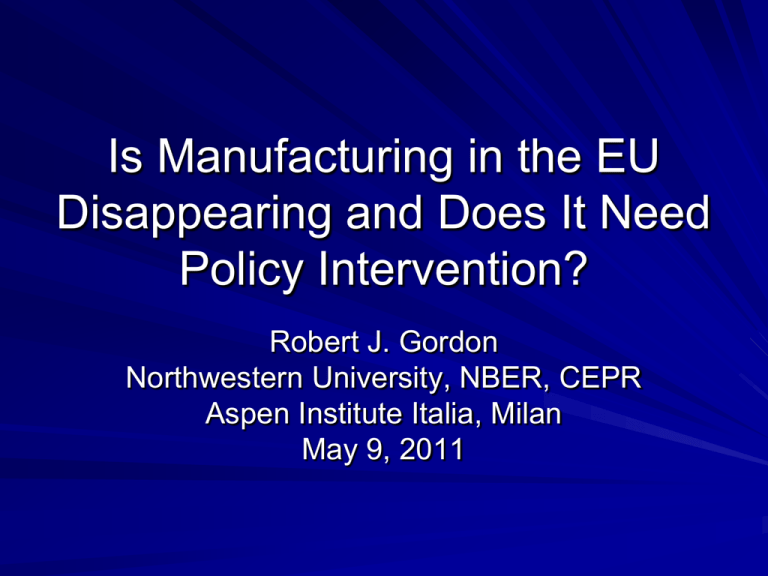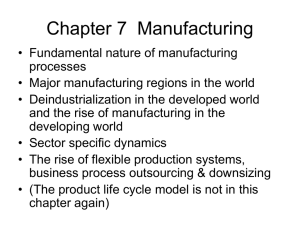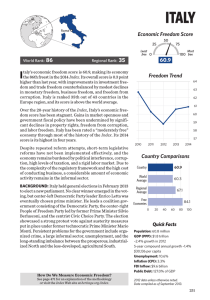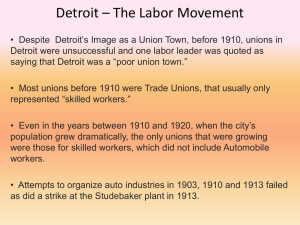Is Manufacturing in the EU Disappearing and Does It Need Policy
advertisement

Is Manufacturing in the EU Disappearing and Does It Need Policy Intervention? Robert J. Gordon Northwestern University, NBER, CEPR Aspen Institute Italia, Milan May 9, 2011 Outline of Brief Initial Comments Is Manufacturing Declining? – Employment vs. Nominal vs. Real VA Shares – EU15 vs. US Manufacturing Productivity Growth in US and EU The Particular Problems of Southern Europe – Diagnosis of the problems – Policy Recommendations and Warnings about Murphy’s Law Manufacturing Shares of GDP for the US, 1977-2007 US- Hours v Nom and Real VA, Mfg as Share of Total GDP, 1977-2007 28 26 24 22 Real VA 20 18 16 Nominal VA Hours 14 12 10 1977 1982 1987 1992 1997 2002 2007 Manufacturing Shares of GDP for the EU-15, 1977-2007 EU- Hours v Nom and Real VA, Mfg as a Share of GDP, 1977-2007 28 26 24 22 Nominal VA Real VA 20 18 Hours 16 14 12 10 1977 1982 1987 1992 1997 2002 2007 Summary of Ratios Employment Share – US 23 to 12. EU 27 to 16. EU higher but similar decline. Nominal VA Share – US 23.5 to 14. EU 25.2 to 19. EU higher but smaller decline Real VA Share – US 18.1 to 17.5. EU 23.7 to 18.7. US almost unchanged, EU converges downward Implications. EU implicit deflator hardly declines; US declines massively. – Annual rate 1977-07, US -1.8 vs. EU -0.3 percent per year Second Implication: Relative productivity growth in US manufacturing rises much faster than EU – Annual rate 1977-07, US 2.2 vs. EU 1.0 percent per year Smoothed Labor Productivity Growth, US vs. EU, Total and Non-Mfg, 1997-2007 Total Economy and Non-Mfg LP Growth Rate, US vs EU, 1978-2007 6 5 4 3 2 EU Total EU Non-Mfg US Total 1 US Non-Mfg 0 1978 1983 1988 1993 1998 2003 Smoothed Labor Productivity Growth, US vs. EU, Mfg, 1997-2007 (note same scale) Manufacturing LP Growth Rate, US vs EU, 1978-2007 6 5 United States 4 3 EU 2 1 0 1978 1983 1988 1993 1998 2003 What Industries Contribute to Productivity Growth Success or Failure? Two next graphs compare – US vs. EU 15 – EU15 vs. Mediterranean (GR, IT, SP) Horizontal axis is TFP growth in EU-15 Vertical axis is TFP in US or Med Note zero vertical line, horizontal line – Lots of negative TFP growth observations Comparing US with EU-15 Real Estate 0.35 Financ e Retail/ 0.25 US TFP Who lesale Business S ervic es ICT No n-ICT Durable Mfg. Mfg. 0.05 Co mmunic atio n GHI No ndurable Mfg 45º line -0.05 Trans. 0.05 0.10 -0.05 Ag./Mining Co nstruc tio n/ Utilities EU TFP Comparing Med with EU-15 Mediterranean GHI Business 0.15 Financ e S ervic es Communic ation 0.05 -0.10 ICT Retail/ Construc tion/ Utilities Mfg. Wholesale Trans. -0.15 Real Estate Non-ICT Durable Nondurable Mfg Mfg. -0.25 0.05 0.10 Ag./Mining Diagnosing Problems: Italy Viewed from the 2010 LIGEP Report Nordic, UK, Ireland (until 2007) have not appreciably lagged the US Italy – The problem is that the firms are too small – Their main ambition is to keep control within the family, so there is no interest in individual or societal wealth building through IPOs. – Smallness fostered by “Worker’s Statute” in 1970. Must have union representation if >15 employees – Constraint on growth has shifted Italy from being a star growth performer in EU-15 before 1990 to a laggard after 1990 Initial Thoughts on Policy There is nothing special about manufacturing that would warrant policies to protect its GDP share – US manufacturing has not added anything to employment in last two decades but has not lost GDP share and its productivity soared. Reasons to question industrial policy to raise manufacturing share – Why resist comparative advantage? – Manufacturing is not the only home of innovation and technology Innovation Outside of Manufacturing Arguably other sectors are as dynamic or more dynamic – Mobile telephones, retailing and supply chain – Retail, wholesale, finance, and business services are the key sectors in which US outperforms Europe – Use of ICT innovations is as important as the manufacturing of ICT equipment. The value-added of China in the iphone is only $6.50 out of a retail price of $499. – Less than the $11 of components exported from US to China – Way less than the $100+ that Apple adds as its markup for intellectual property developed in the U. S. Final Comments on Industrial Policy Decades of Italian investment in the South has not paid off Similarly, UK has not been able to revive its northeast, Germany has poured trillions into East Germany which still lags, and US has not been able to revive Detroit or the Appalachian states Inequality of policy conception and administration can create rather than solve problems – Further example than just Italy imposing union legislation on employers > 15 employees. – US trade union laws have led all transplant foreignowned auto plants to located in the south – Have hollowed out the city of Detroit – US devolution of power to the states leads to a wasteful competition of subsidies to lure new firms and keep old firms (Illinois’ recent $100 million to Motorola Mobility) Controversial Thoughts The analogy of Detroit to Southern Italy raises many interesting questions: The history is different. Southern Italy is an age-old problem, Detroit has become a problem last two decades Policy indirectly created Detroit problem while Italian policy didn’t fix South problem – Murphy’s law (unintended consequences of well-intentioned policies) Unions killed Detroit because they weren’t enforced in South Management killed Detroit by falling behind Japanese management & quality – Italian policies ineffective because of legal system, corruption, culture – Culture also played a difference in Detroit: white flight from a black majority Is there a difference in labor mobility? Flight from Detroit, century-long emigration from Southern Italy?











